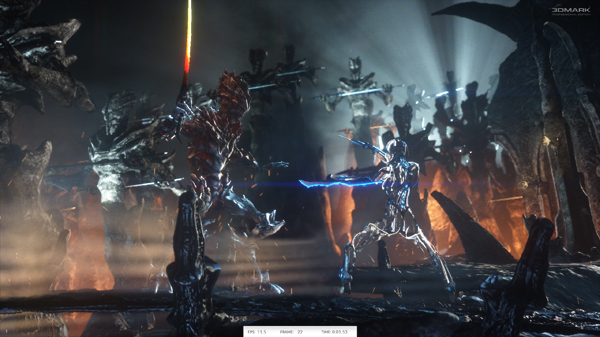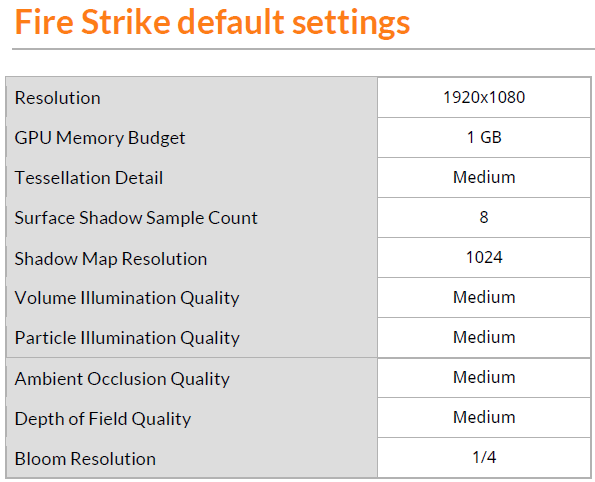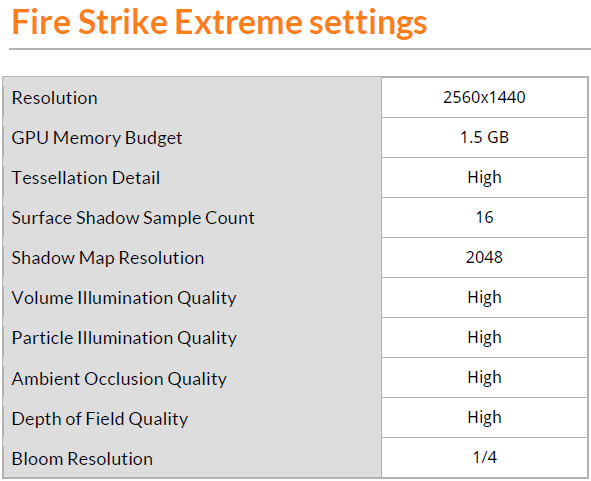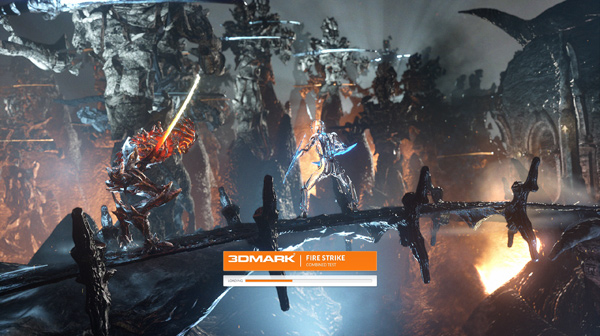Index
Fire Strike uses a multi-threaded DirectX 11 engine and it includes two graphics tests, a physics test and a combined test designed to stress the CPU and GPU at the same time. One of the most important features of the engine is multi-threading, but let's not forget tessellation, advanced lighting, particle illumination, particle-based distortion, depth of field, surface illumination, volumetric illumination, lens reflections, bloom and smoke simulation.

The Fire Strike benchmark can be customized or we can use the Extreme preset. We will not get an overall score for the custom test but individual results from each of the sub-tests and other performance statistics will be available.


The bench will deliver average frame rates, as showed in tables below, for the two graphics tests, the physics and the combined test.
Graphics test 1
3DMark Fire Strike Graphics test 1 focuses on geometry and illumination. Particles are drawn at half resolution and dynamic particle illumination is disabled.
There are 100 shadow casting spot lights and 140 non-shadow casting point lights in the scene. On average, 3.9 million vertices containing 500,000 input patches for tessellation are processed per frame resulting in 5.1 million triangles being rasterized either to the screen or to the shadow maps.
Compute shaders are invoked 1.5 million times per frame for particle simulations and post processing. On average, 80 million pixels are processed per frame, which is lower than in Graphics test 2 as there is no depth of field effect.

|
Graphics test 1 (Average frame rates) |
|
|
XFX HD 7950 Black Edition |
29.94 |
|
XFX HD 7870 Black Edition |
26.07 |
|
XFX HD 7770 Black Edition |
14.32 |
Graphics test 2
3DMark Fire Strike Graphics test 2 focuses on particles and GPU simulations. Particles are drawn at full resolution and dynamic particle illumination is enabled.
There are two smoke fields simulated on GPU. Six shadow casting spot lights and 65 non-shadow casting point lights are present. On average, 2.6 million vertices containing 240,000 input patches for tessellation are processed and 1.4 million primitives are generated with geometry shaders. That results in 5.8 million triangles being rasterized per frame on average.
Compute shaders are invoked 8.1 million times per frame for particle and fluid simulations and for post processing steps. On average, 170 million pixels are processed per frame. Post processing includes a depth of field effect.
|
Graphics test 2 (Average frame rates) |
|
|
XFX HD 7950 Black Edition |
26.61 |
|
XFX HD 7870 Black Edition |
21.99 |
|
XFX HD 7770 Black Edition |
12.55 |
Physics test
3DMark Fire Strike Physics test benchmarks the hardware’s ability to run gameplay physics simulations on the CPU. The GPU load is kept as low as possible to ensure that only the CPU is stressed. The Bullet Open Source Physics Library is used as the physics library for the test.
The test has 32 simulated worlds. One thread per available CPU core is used to run simulations. All physics are computed on CPU with soft body vertex data updated to GPU each frame.
The 3DMark Fire Strike Physics test uses the Bullet Open Source Physics Library.
|
Physics test (Average frame rates) |
|
|
XFX HD 7950 Black Edition |
24.67 |
|
XFX HD 7870 Black Edition |
24.60 |
|
XFX HD 7770 Black Edition |
24.68 |
Combined test
3DMark Fire Strike Combined test stresses both the GPU and CPU simultaneously. The GPU load combines elements from Graphics test 1 and 2 using tessellation, volumetric illumination, fluid simulation, particle simulation, FFT based bloom and depth of field.
The CPU load comes from the rigid body physics of the breaking statues in the background. There are 32 simulation worlds running in separate threads each containing one statue decomposing into 113 parts. Additionally there are 16 invisible rigid bodies in each world except the one closest to camera to push the decomposed elements apart. The simulations run on one thread per available CPU core.
The 3DMark Fire Strike Combined test uses the Bullet Open Source Physics Library.
|
Combined test (Average frame rates) |
|
|
XFX HD 7950 Black Edition |
12.38 |
|
XFX HD 7870 Black Edition |
10.10 |
|
XFX HD 7770 Black Edition |
5.46 |



